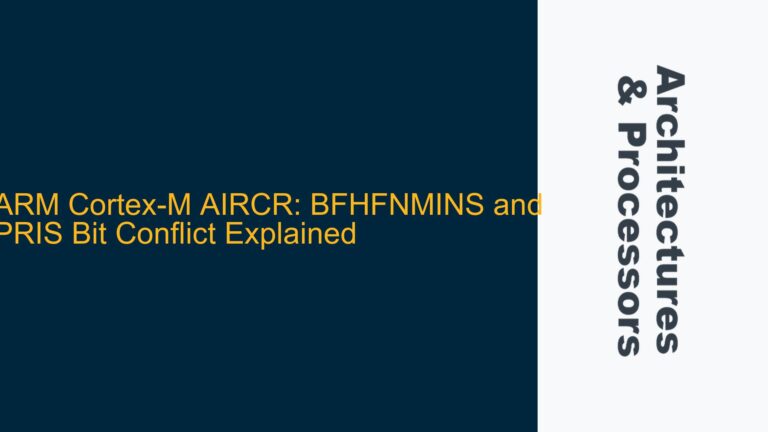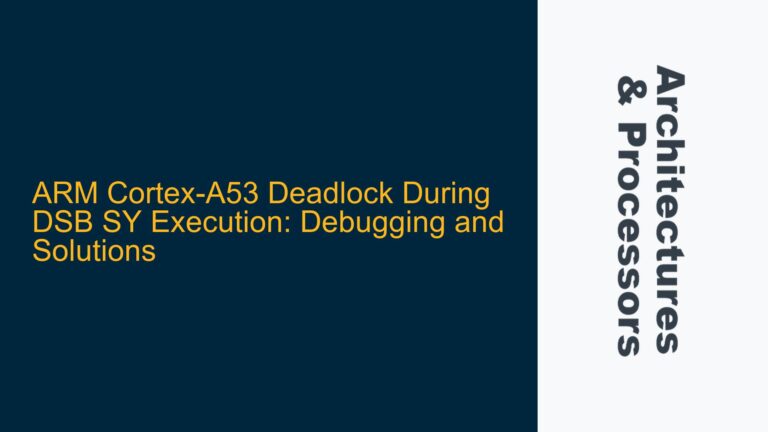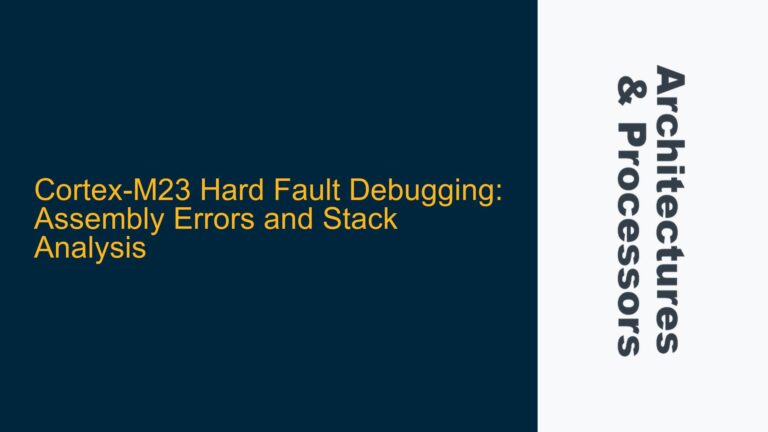ARM Cortex-M0+ Instruction Fetch Mechanism and Pipeline Behavior
The ARM Cortex-M0+ processor is a highly efficient, low-power microcontroller core designed for embedded applications. It employs a 2-stage pipeline (Fetch and Execute) and uses the Thumb instruction set, which primarily consists of 16-bit instructions. The Cortex-M0+ fetches instructions in 32-bit chunks from memory, even though most instructions are 16-bit. This fetch mechanism is optimized for sequential execution, where the processor can fetch two 16-bit instructions in a single cycle when the instruction address is 32-bit aligned.
When the Cortex-M0+ pipeline fetches instructions from a 32-bit aligned address, it retrieves 32 bits of data in one cycle, which typically contains two 16-bit instructions. This allows the pipeline to maintain a steady-state flow, fetching and executing instructions efficiently. However, this behavior changes when a branch instruction targets an address that is not 32-bit aligned. In such cases, the pipeline must adjust its fetch mechanism to handle the misalignment, which can impact performance and pipeline efficiency.
The Cortex-M0+ pipeline is designed to handle unaligned branch targets, but this requires additional fetch cycles to fill the pipeline with the correct instructions. When a branch instruction targets an unaligned address, the processor performs two back-to-back fetches: the first fetch retrieves 16 bits of data (one instruction) from the unaligned address, and the second fetch retrieves 32 bits of data (two instructions) from the next aligned address. This behavior ensures that the pipeline is correctly filled with the target instructions, but it introduces a performance penalty due to the additional fetch cycle.
Impact of Unaligned Branch Addresses on Pipeline Efficiency
The Cortex-M0+ pipeline’s efficiency is heavily dependent on the alignment of instruction addresses. When executing sequential code from a 32-bit aligned address, the pipeline can fetch two 16-bit instructions per cycle, maximizing throughput. However, when a branch instruction targets an unaligned address, the pipeline’s steady-state flow is disrupted, leading to a performance penalty.
The first fetch after an unaligned branch retrieves only 16 bits of data, which corresponds to a single 16-bit instruction. This fetch is necessary to correctly align the pipeline with the target code, but it results in a partial fetch cycle. The second fetch retrieves 32 bits of data, which contains two 16-bit instructions, restoring the pipeline’s ability to fetch two instructions per cycle. This back-to-back fetch sequence introduces a one-cycle delay, as the pipeline must wait for the second fetch to complete before it can resume normal operation.
The performance impact of unaligned branch addresses is more pronounced in tight loops or frequently executed code paths, where the additional fetch cycle can accumulate and degrade overall system performance. In contrast, the Cortex-M0 (non-plus variant) always performs 32-bit instruction fetches, even for unaligned addresses, which can lead to different performance characteristics. The Cortex-M0+ design choice to handle unaligned branches with back-to-back fetches is a trade-off between complexity and performance, aiming to balance efficiency with the simplicity of the pipeline design.
Optimizing Code to Minimize Unaligned Branch Penalties
To mitigate the performance impact of unaligned branch addresses on the Cortex-M0+ pipeline, developers can adopt several strategies to ensure that branch targets are 32-bit aligned. One approach is to align critical code sections, such as frequently executed loops or interrupt service routines, to 32-bit boundaries. This can be achieved using compiler directives or manual alignment techniques, ensuring that branch instructions target aligned addresses and maintain pipeline efficiency.
Another optimization technique involves minimizing the use of branch instructions in performance-critical code paths. By reducing the number of branches and favoring sequential execution, developers can avoid the pipeline disruptions caused by unaligned branch targets. This can be achieved through loop unrolling, inlining small functions, or restructuring code to reduce conditional branches.
In cases where unaligned branches are unavoidable, developers should be aware of the performance implications and carefully profile their code to identify and address any bottlenecks. Tools such as cycle-accurate simulators or performance analyzers can provide insights into the pipeline behavior and help identify opportunities for optimization.
Additionally, developers should consider the impact of unaligned data accesses on the Cortex-M0+ pipeline. While the pipeline is primarily designed to handle instruction fetches, unaligned data accesses can also introduce performance penalties. Ensuring that data structures are aligned to natural boundaries can improve memory access efficiency and reduce the likelihood of pipeline stalls.
In summary, the Cortex-M0+ pipeline’s handling of unaligned branch addresses introduces a performance penalty due to the need for back-to-back fetches. By aligning critical code sections, minimizing branch instructions, and profiling performance, developers can optimize their code to maintain pipeline efficiency and achieve the best possible performance on the Cortex-M0+ processor.
Detailed Analysis of Cortex-M0+ Pipeline Behavior
To further understand the Cortex-M0+ pipeline behavior, let’s delve into the specifics of the fetch and execute stages. The fetch stage is responsible for retrieving instructions from memory, while the execute stage decodes and executes the fetched instructions. The pipeline’s efficiency is determined by how well these stages can overlap and maintain a steady flow of instructions.
When the Cortex-M0+ fetches instructions from a 32-bit aligned address, it retrieves 32 bits of data in one cycle, which typically contains two 16-bit instructions. This allows the fetch stage to supply the execute stage with a continuous stream of instructions, maximizing throughput. However, when a branch instruction targets an unaligned address, the fetch stage must adjust its behavior to correctly align the pipeline with the target code.
The first fetch after an unaligned branch retrieves only 16 bits of data, which corresponds to a single 16-bit instruction. This fetch is necessary to correctly align the pipeline with the target code, but it results in a partial fetch cycle. The second fetch retrieves 32 bits of data, which contains two 16-bit instructions, restoring the pipeline’s ability to fetch two instructions per cycle. This back-to-back fetch sequence introduces a one-cycle delay, as the pipeline must wait for the second fetch to complete before it can resume normal operation.
Performance Implications of Unaligned Branches
The performance impact of unaligned branch addresses is more pronounced in tight loops or frequently executed code paths, where the additional fetch cycle can accumulate and degrade overall system performance. For example, consider a loop that iterates 1000 times and contains a branch instruction targeting an unaligned address. Each iteration of the loop will incur a one-cycle penalty due to the unaligned branch, resulting in a total performance degradation of 1000 cycles.
In contrast, if the branch target is aligned to a 32-bit boundary, the pipeline can fetch two instructions per cycle, maintaining optimal throughput. This highlights the importance of aligning critical code sections to minimize the performance impact of unaligned branches.
Comparison with Cortex-M0 Pipeline Behavior
The Cortex-M0 (non-plus variant) always performs 32-bit instruction fetches, even for unaligned addresses. This means that the Cortex-M0 pipeline does not require back-to-back fetches to handle unaligned branch targets. Instead, it fetches 32 bits of data in a single cycle, regardless of the alignment of the branch target. This behavior can lead to different performance characteristics compared to the Cortex-M0+.
While the Cortex-M0’s approach to handling unaligned branches may seem more efficient, it comes with its own set of trade-offs. The Cortex-M0’s pipeline design is more complex, as it must handle unaligned fetches without disrupting the pipeline flow. This complexity can lead to increased power consumption and area overhead, which may not be desirable in low-power embedded applications.
In contrast, the Cortex-M0+ design choice to handle unaligned branches with back-to-back fetches is a trade-off between complexity and performance, aiming to balance efficiency with the simplicity of the pipeline design. This approach allows the Cortex-M0+ to maintain a simple and efficient pipeline while still providing reasonable performance for most embedded applications.
Practical Considerations for Developers
Developers working with the Cortex-M0+ should be aware of the pipeline’s behavior when handling unaligned branch addresses and take steps to optimize their code accordingly. One practical consideration is the use of compiler directives to align critical code sections. Most modern compilers provide directives or attributes that allow developers to specify the alignment of functions or code sections. For example, in GCC, the aligned attribute can be used to align a function to a 32-bit boundary:
void __attribute__((aligned(4))) critical_function() {
// Critical code section
}
By aligning critical code sections to 32-bit boundaries, developers can ensure that branch instructions target aligned addresses, minimizing the performance impact of unaligned branches.
Another practical consideration is the use of performance profiling tools to identify and address pipeline bottlenecks. Tools such as cycle-accurate simulators or performance analyzers can provide insights into the pipeline behavior and help developers identify opportunities for optimization. By profiling their code and identifying frequently executed code paths, developers can focus their optimization efforts on the most critical sections of their application.
Conclusion
The ARM Cortex-M0+ pipeline’s handling of unaligned branch addresses introduces a performance penalty due to the need for back-to-back fetches. By aligning critical code sections, minimizing branch instructions, and profiling performance, developers can optimize their code to maintain pipeline efficiency and achieve the best possible performance on the Cortex-M0+ processor. Understanding the pipeline’s behavior and its impact on performance is essential for developing efficient and reliable embedded applications.






